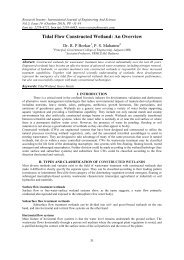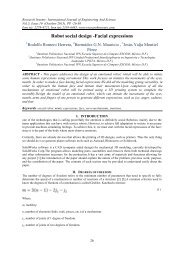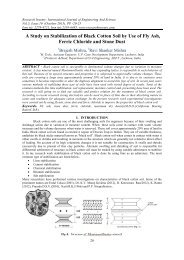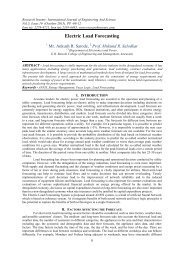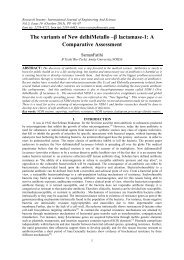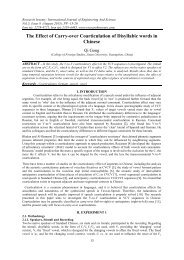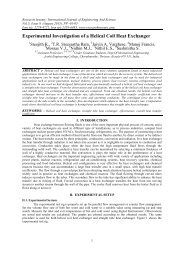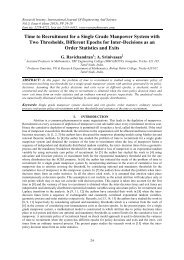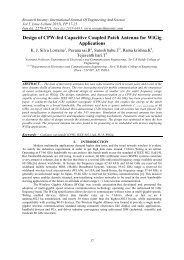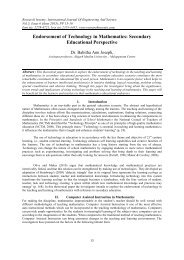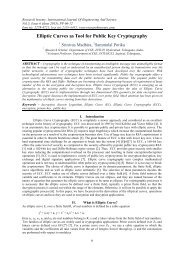Effect of Isolate of Trichoderma Sp. And Incubation Period to Glucose Production
- No tags were found...
Create successful ePaper yourself
Turn your PDF publications into a flip-book with our unique Google optimized e-Paper software.
Research Inventy: International Journal <strong>of</strong> Engineering <strong>And</strong> Science<br />
Vol.5, Issue 8 (August 2015), PP -21-25<br />
Issn (e): 2278-4721, Issn (p):2319-6483, www.researchinventy.com<br />
<strong>Effect</strong> <strong>of</strong> <strong>Isolate</strong> <strong>of</strong> <strong>Trichoderma</strong> <strong>Sp</strong>. <strong>And</strong> <strong>Incubation</strong> <strong>Period</strong> <strong>to</strong><br />
<strong>Glucose</strong> <strong>Production</strong><br />
1,2 Arief Budiono, 1,3 Suharjono, 1,4 Imam San<strong>to</strong>so, 1,5 Soemarno<br />
1 Doc<strong>to</strong>rate Program on Environmental Science,University <strong>of</strong> Brawijaya, Malang. Indonesia<br />
2 Department <strong>of</strong> Chemical Engineering, The State Polytechnic <strong>of</strong> Malang, Indonesia<br />
3 Faculty <strong>of</strong> Mathematics and Natural Science, University <strong>of</strong> Brawijaya, Malang. Indonesia<br />
4 Faculty <strong>of</strong> Agricultural Technology, University <strong>of</strong> Brawijaya, Malang. Indonesia<br />
5 Faculty <strong>of</strong> Agriculture, University <strong>of</strong> Brawijaya, Malang. Indonesia<br />
ABSTRACT: This study was carried out <strong>to</strong> determine the effect <strong>of</strong> isolates <strong>of</strong> <strong>Trichoderma</strong> sp. and the<br />
incubation period <strong>to</strong> glucose production. A glucose produced by the three isolates <strong>of</strong> <strong>Trichoderma</strong> sp. (TV.0209,<br />
TV.0305 and TV.0710) which were obtained from the collection <strong>of</strong> the Labora<strong>to</strong>ry <strong>of</strong> Microbiology,<br />
Department <strong>of</strong> Chemical Engineering <strong>of</strong> The State Polytechnic <strong>of</strong> Malang. It was determined that the isolates<br />
had a significant correlation in producing glucose with incubation period for 10 days. Data were then<br />
analyzed using two-way anova with the alpha <strong>of</strong> 5% and using Micros<strong>of</strong>t Excel. <strong>Isolate</strong> TV.0209 was capable <strong>to</strong><br />
produce the highest average <strong>of</strong> a <strong>to</strong>tal glucose production (3,616 ppm) when compared with TV.0305 (3,253<br />
ppm) and TV.0710 (2,448 ppm). The optimum incubation period <strong>of</strong> treatment isolate variables was achieved<br />
during 6 days.<br />
Keywords: <strong>Incubation</strong> <strong>Period</strong>, <strong>Trichoderma</strong>, Cellulase, <strong>Glucose</strong><br />
I. INTRODUCTION<br />
Various microbes utilize organic materials as an energy source. This process is usually followed by the<br />
formation <strong>of</strong> a bioactiva<strong>to</strong>r enzymes in decomposing organic compounds which change a complex polymer in<strong>to</strong><br />
simpler compounds. The addition <strong>of</strong> microbes in<strong>to</strong> organic material can be regulated and controlled in such a<br />
way that the decomposition process can occur more quickly. Various ways <strong>of</strong> arrangements regarding the type<br />
and environmental conditions have been carried out in order <strong>to</strong> select organic materials which will be<br />
decomposed in<strong>to</strong> simpler compounds.<br />
<strong>Trichoderma</strong> is a fungus producing cellulolytic enzyme <strong>to</strong> degrade compound cellulose in<strong>to</strong> glucose by<br />
enzyme called glucosidase. Each species <strong>of</strong> <strong>Trichoderma</strong> produces certain enzyme in decomposing cellulose<br />
material <strong>of</strong> the agricultural waste [1,2]. Fungus <strong>Trichoderma</strong> sp. is a potential agent <strong>to</strong> produce cellulase<br />
enzymes that degrade cellulose materials. In addition, these microbes can also act as an antagonist against<br />
phy<strong>to</strong>pathogen [3]. Cellulase <strong>of</strong> these organisms have been isolated and studied from the genus <strong>Trichoderma</strong><br />
[4]. The medium used for inoculation is usually carried out on PDA (Pota<strong>to</strong> Dextrose Agar). Enzyme production<br />
close relation <strong>to</strong> a way <strong>of</strong> controlling microorganisms so that productivity can be improved and modified by this<br />
control. Cellulase produced depends on several fac<strong>to</strong>rs such as pH, temperature, incubation period, source <strong>of</strong><br />
carbon, and nitrogen [5].<br />
Several previous researches have determined that many strains <strong>of</strong> <strong>Trichoderma</strong> sp. potential <strong>to</strong> produce<br />
cellulase enzymes in higher quantities than bacteria [6]. The enzymatic hydrolysis <strong>of</strong> cellulose is more<br />
advantageous than using some chemical acid. Processing <strong>of</strong> enzymatic hydrolysis is not causing corrotion,<br />
requiring less time, and resulting glucose levels higher in optimum conditions [7].<br />
Several types <strong>of</strong> bacteria, such as actinomycetes and fungi can produce extracellular cellulase that<br />
indicated with glucose produced when grown on a substrate containing cellulose. Cellulose is an organic<br />
material <strong>of</strong> the abundant presence in the natural world around us. Generally, some agricultural waste contains<br />
cellulose 46.6% were able <strong>to</strong> be decomposed by <strong>Trichoderma</strong> viride in<strong>to</strong> glucose [8].<br />
Cellulase enzymes can be produced among others by fungi or bacteria. Normally, the production <strong>of</strong><br />
commercial enzyme using fungi or bacteria. Fungi that can produce cellulase : species <strong>of</strong> <strong>Trichoderma</strong><br />
(<strong>Trichoderma</strong> viride, <strong>Trichoderma</strong> longibrachiatum), Aspergillus (Aspergillus fumigates, Aspergillus nidulans),<br />
and Penicillium [9]. Cellulase is an enzyme that can hydrolyze the bond β-1,4 on cellulose which is composed<br />
<strong>of</strong> three types [10]; The first type endoglucanase or carboxymethyl cellulase (CMCase) which breaks the bonds<br />
β-1,4-D-glucoside <strong>to</strong> produce oligosaccharides and monosaccharides such as glucose. While the second and the<br />
third type is a β-glucosidase (β-1,4-D-glucoside glucohydrolase) and exoglucanase (exo-β-1,4-glucanase) [11].<br />
21
22<br />
<strong>Effect</strong> Of <strong>Isolate</strong> Of <strong>Trichoderma</strong><br />
II. MATERIALS AND METHODS<br />
Material<br />
The experiment was conducted <strong>to</strong> determine the ability <strong>of</strong> isolates <strong>of</strong> <strong>Trichoderma</strong> sp. in producing<br />
glucose. Three isolates <strong>of</strong> <strong>Trichoderma</strong> sp. (TV.0209, TV.0305 and TV.0710) were obtained from the<br />
collection <strong>of</strong> the Labora<strong>to</strong>ry <strong>of</strong> Microbiology Department <strong>of</strong> Chemical Engineering Polytechnic <strong>of</strong> Malang.<br />
While the Standard <strong>Glucose</strong> material obtained from E-Merck and support materials purchased from local<br />
products.<br />
Preparation Method <strong>of</strong> Culture<br />
Experimental variables were three isolates <strong>of</strong> <strong>Trichoderma</strong> sp. and incubation period. The glucose<br />
concentration was determined spectropho<strong>to</strong>metrically by measuring the absorbance <strong>of</strong> the standard solutions.<br />
Three isolates <strong>of</strong> <strong>Trichoderma</strong> sp. TV.0209, TV.0305 and TV.0710 subcultured using scratch and incubated at<br />
30°C for 5 days. Each isolate <strong>of</strong> <strong>Trichoderma</strong> sp. made conidia suspension with a density <strong>of</strong> 10 7 conidia / ml. 10<br />
ml <strong>of</strong> the conidial suspension at each isolate was incubated for ten days. The beginning <strong>of</strong> each two-day<br />
incubation and the amount <strong>of</strong> glucose was analyzed by measuring the absorbance. Measurement potential <strong>of</strong> the<br />
<strong>Trichoderma</strong> sp. isolates in producing glucose was measured by a Perkin Elmer UV/Vis <strong>Sp</strong>ectropho<strong>to</strong>meter at a<br />
wavelength <strong>of</strong> 540 nm.<br />
Statistical Method<br />
Methods used for data analysis <strong>of</strong> the potential <strong>of</strong> the <strong>Trichoderma</strong> sp. isolates in producing glucose<br />
were graphical and statistical methods. Tests were conducted <strong>to</strong> determine the effect <strong>of</strong> incubation period <strong>of</strong> the<br />
isolates. Graphical method was used <strong>to</strong> determine the optimum incubation period which have a real impact.<br />
Statistical methods for testing was carried out by observing data. The first test based on the hypothesis by<br />
comparing the average value using anova. Meanwhile, the second test sample used by each group had<br />
considered that category <strong>of</strong> isolate and incubation period corresponding anova was done with a two-way anova<br />
with interactions.<br />
At the two-way anova with interaction, three hypotheses were used as follow.<br />
3.1 Hypothesis column<br />
H0 : μ 1 = μ = μ * 2 * 3, there was no significant difference between the average value calculated incubation<br />
periods category.<br />
H1 : μ * 1 ≠ μ ≠ μ * 2 * 3, there was a significant difference between the average value calculated from<br />
incubation periods category.<br />
3.2 Hypothesis line<br />
H0 : μ1 μ2 * = * = μ3 *, there was no significant difference between the average value calculated from isolates<br />
category.<br />
H1 : μ1 ≠ μ2 * * ≠ μ3 *, there was a significant difference between the average value calculated from isolates<br />
category.<br />
3.3 Hypothesis interaction<br />
H0: (ab) 11 = (ab) 12 = ... .. = (ab) kj, there was no significant interaction between the incubation period and<br />
isolate.<br />
H1: (ab) 11 ≠ (ab) ≠ 12 ... .. ≠ (ab) kj, there was a significant interaction between the incubation period and<br />
isolate.<br />
III. RESULTS AND DISCUSSION<br />
<strong>Glucose</strong> produced from the decomposition <strong>of</strong> organic matter is determined by means <strong>of</strong><br />
spectropho<strong>to</strong>metry. A standard curve is plotted by observing the absorbance produced by each glucose<br />
concentration. Absorbance <strong>of</strong> each glucose concentrations are presented in Table 1. While the magnitude <strong>of</strong><br />
absorbance resulting from the various incubation period is presented in Table 2.<br />
Table 1. Results <strong>of</strong> the absorbance <strong>of</strong> various glucose concentrations<br />
glucose concentrations (ppm)<br />
absorbance<br />
10 0,094<br />
20 0,200<br />
30 0,351<br />
40 0,495<br />
50 0,632<br />
60 0,789
<strong>Incubation</strong> period (day)<br />
<strong>Effect</strong> Of <strong>Isolate</strong> Of <strong>Trichoderma</strong><br />
Data from the absorbance <strong>of</strong> various glucose concentrations is made a standard curve that is used <strong>to</strong><br />
determine the amount <strong>of</strong> glucose through the absorbance produced by each isolate at various incubation periods.<br />
Results <strong>of</strong> calibration Table 1 <strong>to</strong> standard glucose shows a linear regression equation y = -0.0647 + 0.1404x. On<br />
this equation, y = absorbance while x = glucose concentration<br />
Table 2. Results <strong>of</strong> isolates absorbance at various incubation periods<br />
incubation period (day)<br />
<strong>Isolate</strong> 0 2 4 6 8 10<br />
TV.0209<br />
TV.0305<br />
TV.0710<br />
0.028 0.100 0.488 0.697 0.605 0.502<br />
0.031 0.107 0.457 0.748 0.647 0.538<br />
0.035 0.109 0.780 0.815 0.706 0.580<br />
0.025 0.090 0.382 0.635 0.557 0.465<br />
0.030 0.102 0.573 0.690 0.615 0.545<br />
0.028 0.096 0.469 0.668 0.588 0.502<br />
0.020 0.062 0.375 0.416 0.388 0.360<br />
0.025 0.080 0.398 0.427 0.393 0.358<br />
0.017 0.095 0.414 0.435 0.402 0.364<br />
1.<br />
The effect <strong>of</strong> isolates TV.0209 , TV.0305 and TV.0710 <strong>to</strong> incubation period can be described in Figure<br />
<strong>Isolate</strong>s TV.0209, TV.0305 and TV.0710<br />
Figure 1. The <strong>Effect</strong> <strong>of</strong> <strong>Isolate</strong>s <strong>to</strong> <strong>Incubation</strong> <strong>Period</strong>s<br />
There is a correlation between isolates and incubation periods. The isolates TV.0209, TV.0305, and TV.0710<br />
have showed a similar pattern. Optimum results <strong>of</strong> incubation period occur on the sixth day. <strong>Isolate</strong> <strong>of</strong> TV.0209<br />
has a value with highest effect compared <strong>to</strong> isolate <strong>of</strong> TV.0305 and TV.0710. Furthermore, data on Table 2 are<br />
tested using two-way anova with the alpha 0.05 or 5%. The results <strong>of</strong> the analysis are processed using Micros<strong>of</strong>t<br />
Excel and presented on Table 3.<br />
Table 3. Test Results <strong>of</strong> Two Fac<strong>to</strong>rs with Three Repetitions<br />
incubation period (day) 0 2 4 6 8 10 Total<br />
TV.0209<br />
Count 3 3 3 3 3 3 18<br />
Sum 0.094 0.316 1.725 2.260 1.958 1.620 7.973<br />
Average 0.031 0.105 0.575 0.753 0.653 0.540 0.443<br />
23
<strong>Effect</strong> Of <strong>Isolate</strong> Of <strong>Trichoderma</strong><br />
Variance 0.000 0.000 0.032 0.004 0.003 0.002 0.084<br />
TV.0305<br />
Count 3 3 3 3 3 3 18<br />
Sum 0.083 0.288 1.424 1.993 1.760 1.512 7.060<br />
Average 0.028 0.096 0.475 0.664 0.587 0.504 0.392<br />
Variance 0.000 0.000 0.009 0.001 0.001 0.002 0.064<br />
TV.0710<br />
Count 3 3 3 3 3 3 18<br />
Sum 0.062 0.237 1.187 1.278 1.183 1.082 5.029<br />
Average 0.021 0.079 0.396 0.426 0.394 0.361 0.279<br />
Variance 0.000 0.000 0.000 0.000 0.000 0.000 0.029<br />
Total<br />
Count 9 9 9 9 9 9<br />
Sum 0.239 0.841 4.336 5.531 4.901 4.214<br />
Average 0.027 0.093 0.482 0.615 0.545 0.468<br />
Variance 0.000 0.000 0.016 0.023 0.014 0.008<br />
Table 3 shows that the test is performed with three repetitions. The average <strong>to</strong>tal value <strong>of</strong> glucose for<br />
each isolate TV.0209 has 0443 (3,616 ppm) with variance 0084, TV.0305 has 0392 (3,253 ppm) with variance<br />
0.064 and TV.0710 has 0279 (2,448 ppm) with variance 0.029.<br />
The <strong>to</strong>tal average results show that isolates TV.0209 have a <strong>to</strong>tal average <strong>of</strong> the highest compared <strong>to</strong> TV.0305,<br />
while TV.0710 has a <strong>to</strong>tal average <strong>of</strong> the lowest. The same pattern occurs in which the variance TV.0209 has<br />
the highest value compared <strong>to</strong> TV.0305 and TV.0710. Analysis <strong>of</strong> <strong>to</strong>tal isolates TV.0209, TV.0305, and<br />
TV.0710 obtained <strong>to</strong>tal value <strong>of</strong> the average <strong>of</strong> 0.468 and 0.008 variance.<br />
Table 4. Test Results <strong>of</strong> Two-Way Anova<br />
Source <strong>of</strong> Variation SS df MS F P-value F crit<br />
Sample 0.252 2 0.126 43.160 0.000 3.259<br />
Columns 2.762 5 0.552 188.944 0.000 2.477<br />
Interaction 0.131 10 0.013 4.493 0.000 2.106<br />
Within 0.105 36 0.003<br />
Total 3.250 53<br />
To determine the effect <strong>of</strong> incubation time isolates against statistically performed using two-way<br />
anova with the following results. Hypothesis column in Table 3, show the p value less than 0.05, then the<br />
decision <strong>to</strong> accept H 1 and reject H 0 . Furthermore, it appears the value <strong>of</strong> F is higher than F crit . In other words,<br />
F calculated > F table . It means that there is a significant difference between the average value calculated from<br />
categories <strong>of</strong> incubation period. Each isolate that is different glucose results in any period <strong>of</strong> incubation. Each<br />
incubation period applied for a 10 days, <strong>Trichoderma</strong> isolates give results significantly different values. This<br />
difference indicates that production <strong>of</strong> glucose produced by cellulase enzyme activity which produced by each<br />
isolate. The results <strong>of</strong> this study reinforce the research data conducted by Awojobi et al. [12] who did research<br />
some <strong>Trichoderma</strong> isolates within 5 <strong>to</strong> 11 days incubation. Research results mention that there are significant<br />
differences between the amount <strong>of</strong> cellulase with incubation period.<br />
Hypotheses rows showed the p value less than 0.05, then the decision <strong>to</strong> accept H 1 and reject H 0 . It<br />
appears the value <strong>of</strong> F > F crit means that there is a significant difference between the average value calculated<br />
from categories <strong>of</strong> isolates. Each isolate TV.0209, TV.0305, and TV.0710 have significantly different values in<br />
producing glucose at any incubation period. This data is confirmed by the results <strong>of</strong> research Singh et al. [13]<br />
which states that the ability <strong>of</strong> each species <strong>Trichoderma</strong> growth generally depend on a variety <strong>of</strong> organic<br />
materials applied in degrading complex compounds in<strong>to</strong> simpler compounds. The large amount <strong>of</strong> degraded<br />
compounds associated with the incubation period applied in its growth. Therefore, each species <strong>Trichoderma</strong><br />
can be determined the optimum conditions that exist in the resulting product.<br />
24
<strong>Effect</strong> Of <strong>Isolate</strong> Of <strong>Trichoderma</strong><br />
The hypothesis interaction showed the p value less than 0.05, then the decision <strong>to</strong> accept H 1 and<br />
reject H 0 . the value <strong>of</strong> F > F crit . It means that there is a significant difference in the interaction between isolates<br />
TV.0209, TV.0305, and TV.0710 with any incubation period. It is also supported by the results <strong>of</strong> research<br />
conducted by Bhosle [14] and Maiko [15] which states that there are several types <strong>of</strong> microorganisms such as<br />
bacteria and fungi have a certain incubation period for the state or the substrate, temperature and growth media.<br />
The amount <strong>of</strong> time each microorganism incubation correlated with the rate <strong>of</strong> growth in organic medi. There is<br />
a significant correlation between some strains <strong>of</strong> Pseudomonas sp., Rhizopus sp,. and <strong>Trichoderma</strong> sp. <strong>to</strong><br />
incubation period <strong>of</strong> 3, 7, 1, and 14 days in degrading organic matter. Besides the concentration <strong>of</strong> organic<br />
matter will also determine the level <strong>of</strong> degradation <strong>of</strong> organic compounds produced.<br />
IV. CONCLUSION<br />
This research results using graphical method and statistical tests show that there are significant<br />
TV.0209 isolates, TV.0305 and TV.0710 against incubation time. TV.0209 isolates have <strong>to</strong>tal influence <strong>of</strong> the<br />
highest average glucose levels <strong>of</strong> 3.253 ppm when compared <strong>to</strong> isolates TV.0305 (3.253 ppm) and TV.0710<br />
(2.448 ppm) with the optimum period <strong>of</strong> 6 days. The test results <strong>of</strong> two-way anova with interactions also<br />
showed that the influence <strong>of</strong> the isolates had a significant influence on the incubation period. <strong>Isolate</strong>s TV.0209,<br />
TV.0305, and TV.0710 as decomposers <strong>of</strong> organic material, capable <strong>of</strong> accelerating the decomposition <strong>of</strong><br />
blo<strong>to</strong>ng in no more than six days <strong>of</strong> the incubation period. It can be concluded that fungus <strong>Trichoderma</strong> sp. is a<br />
high potential as a producer <strong>of</strong> cellulase enzymes.<br />
REFERENCES<br />
[1] Lee, R.L., Paul, J.W., Willem, H.V. and Isak, S.P. (2002) Microbial Cellulose Utilization: Fundamentals and Biotechnology.<br />
Microbiology and Molecular Biology Reviews, 66 (3), 506-577.<br />
[2] Chauve, M. et al. (2010) Comparative kinetic analysis <strong>of</strong> two fungal β-glucosidases. Biotechnology for Bi<strong>of</strong>uels, 3 (3), 97-112.<br />
[3] Budiono, A., Suharjono, San<strong>to</strong>so, I. and Soemarno, (2013) Application Compost <strong>of</strong> Mud Cake by <strong>Trichoderma</strong> Viride Apt01<br />
<strong>to</strong> Apples <strong>to</strong> Increase <strong>Production</strong> in Bumiaji Batu. International Journal Of Engineering <strong>And</strong> Science, 3, 17-20.<br />
[4] Yazdi, M.T., Woodland, J.R., Radford, A. (1990) The cellulase <strong>of</strong> Neurospora crassa : activity, stability and release. Journal<br />
<strong>of</strong> General Microbiology, 136, 1313-1319.<br />
[5] Narasimha, G., Sridevi, A., Viswanath, B., Subbosh, C.M., Rajashekar, R.B. (2006) Nutrien <strong>Effect</strong>s on <strong>Production</strong> <strong>of</strong><br />
Cellulolytic Enzymes by Aspergillus niger. African Journal <strong>of</strong> Biotechnology, 5 (5), 472-476.<br />
[6] Amouri, B. and Gargouri, A. (2006) Characterization <strong>of</strong> a novel β-glucosidase from a Stachybotrys strain. Biochem. Eng. J.,<br />
32, 191-197.<br />
[7] An<strong>to</strong>ny, (2012) Produksi Enzim Selulase. Fakultas Teknologi Industri, Institut Teknologi Bandung, hal. 11-33.<br />
[8] Maheswari, UN. and Aiswarya, K. (2012) Conversion <strong>of</strong> Natural Wastes in<strong>to</strong> Sugar by Trichoderme viride. International<br />
Journal <strong>of</strong> Chemical and Pharmaceutical Sciences, 3 (2), 8-12.<br />
[9] Omojasola, P. et al., (2008) Cellulose <strong>Production</strong> by Some Fungi Cultured on Pineapple Waste. Nature & Science, 6 (2), 64-<br />
75.<br />
[10] Ikram, U.H., Javed, M.M., Khan, T.S. and Siddiq, Z. (2005) Cot<strong>to</strong>n Saccharifying Activity <strong>of</strong> Cellulases Produced by Coculture<br />
<strong>of</strong> Aspergillus niger and <strong>Trichoderma</strong> viride. Res. J. Agric & Biol. Sci., 1(3), 241-245.<br />
[11] Zhang, YH., Cui, J., Lynd, L.R. and Kuang, L.R. (2006) A transition from cellulose swelling <strong>to</strong> cellulose dissolution by o-<br />
phosphoric acid: evidence from enzymatic hydrolysis and supramolecular structure. Biomacromolecules, 7 (2), 644-648.<br />
[12] Awojobi, K.O. et al. (2013) The screening and selection <strong>of</strong> trichoderma species capable <strong>of</strong> producing extracellular cellulolytic<br />
enzymes from soil <strong>of</strong> decaying plant materials. Ife Journal <strong>of</strong> Science, 15(2), 263-271.<br />
[13] Singh, V. et al. (2014) Optimal Physical Parameters for Growth <strong>of</strong> <strong>Trichoderma</strong> <strong>Sp</strong>ecies at Varying pH, Temperature and<br />
Agitation. Virol. <strong>And</strong> Mycol., 3, 1-7.<br />
[14] Bhosle, N.P., Khan, Z.S. and Nasreen, S. (2013) In-vitro degradation <strong>of</strong> Cypermethrin through microorganisms by scale up<br />
technique. International Journal <strong>of</strong> Advanced Research, 1 (7), 229-238.<br />
[15] Maiko, W. et al., (2014) Characteristics <strong>of</strong> bacterial and fungal growth in plastic bottled beverages under a consuming<br />
condition model. Journal <strong>of</strong> Environmental Science and Health, 49 (7), 819-826.<br />
25



